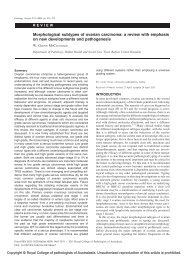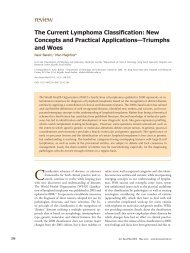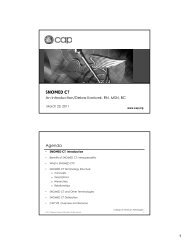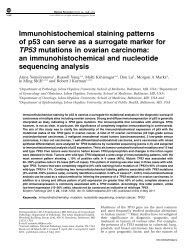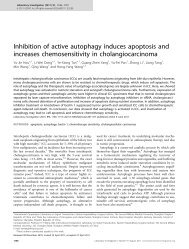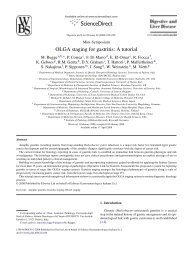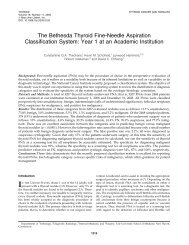Squamous cell and adenosquamous carcinomas of ... - BPA Pathology
Squamous cell and adenosquamous carcinomas of ... - BPA Pathology
Squamous cell and adenosquamous carcinomas of ... - BPA Pathology
You also want an ePaper? Increase the reach of your titles
YUMPU automatically turns print PDFs into web optimized ePapers that Google loves.
<strong>Squamous</strong> <strong>cell</strong> <strong>carcinomas</strong> <strong>of</strong> the gallbladder<br />
JC Roa et al 1071<br />
morules that can be seen in other neoplasms<br />
including ‘adenomas’ <strong>of</strong> gallbladder. In all cases,<br />
the squamous <strong>cell</strong>s exhibited either or both cytologic<br />
atypia <strong>and</strong>/or dyskeratosis characteristic <strong>of</strong> malignant<br />
squamous <strong>cell</strong>s.<br />
Pure squamous <strong>cell</strong> carcinoma<br />
Those invasive <strong>carcinomas</strong> composed exclusively <strong>of</strong><br />
squamous differentiation without any recognizable<br />
invasive gl<strong>and</strong>ular component were classified as<br />
pure squamous <strong>cell</strong> <strong>carcinomas</strong>. This definition is<br />
very similar to that employed in urinary bladder.<br />
Presence <strong>of</strong> gl<strong>and</strong>ular dysplasia/carcinoma in situ<br />
was not considered a criterion <strong>of</strong> exclusion, as long<br />
as there were no invasive gl<strong>and</strong>ular elements.<br />
Adenosquamous carcinoma<br />
If the squamous component <strong>of</strong> the tumor constituted<br />
25–99% <strong>of</strong> the tumor, it was classified as <strong>adenosquamous</strong><br />
carcinoma. The ‘25%’ cut<strong>of</strong>f was selected<br />
arbitrarily as has been done for mixed differentiation<br />
cancers <strong>of</strong> other organs including the pancreas,<br />
where ‘mixed’ <strong>carcinomas</strong> have been well defined. 37<br />
Carcinoma with focal squamous change<br />
Cases in which the squamous component constituted<br />
o25% <strong>of</strong> the tumor were placed in this<br />
category <strong>and</strong> excluded from the analysis.<br />
Histopathological Analysis<br />
After the study cohort was identified based on the<br />
definitions provided above, it was then further<br />
analyzed for other morphological patterns <strong>and</strong> variations<br />
including amount <strong>of</strong> keratin, clear <strong>cell</strong> change,<br />
sarcomatoid change, goblet <strong>cell</strong>s, sebaceous differentiation,<br />
cyst formation <strong>and</strong> necrosis. Association with<br />
an intracholecystic papillary tubular neoplasm, if<br />
present, was also duly recorded. Intracholecystic<br />
papillary tubular neoplasm is an unifying term the<br />
authors employ 38–40 for all the tumoral intraepithelial<br />
neoplasms that are 41 cm, occurring in the gallbladder<br />
including what World Health Organization 1 refers<br />
as ‘adenoma’ <strong>and</strong> ‘intracystic papillary neoplasm’<br />
(papillary adenomas, <strong>and</strong> adeno<strong>carcinomas</strong>). In other<br />
words, these are gallbladder counterparts <strong>of</strong> pancreatic<br />
intraductal papillary mucinous neoplasms, 1 biliary<br />
intraductal papillary neoplasms, 1 <strong>and</strong> intraampullary<br />
papillary tubular neoplasms. 1,38–41<br />
In addition, both the study group <strong>and</strong> a control<br />
group (composed <strong>of</strong> 50 cases r<strong>and</strong>omly selected<br />
from the excluded cases without any squamous<br />
differentiation) were analyzed for the following<br />
parameters: histological grade (well, moderate or<br />
poor, as determined by conventional approach),<br />
vascular invasion, perineural invasion, tumor giant<br />
<strong>cell</strong>s <strong>and</strong> the amount <strong>of</strong> ‘tumor-infiltrating’ inflammatory<br />
<strong>cell</strong>s (eosinophils <strong>and</strong> lymphocytes) as<br />
defined in other studies; 42–44 ie, those associated<br />
preferentially with the tumor (in the vicinity <strong>of</strong> the<br />
tumor, in between the tumor <strong>cell</strong>s or immediately<br />
adjacent to tumor <strong>cell</strong> clusters). The inflammation<br />
was semiquantitatively scored as 0 ¼ none,<br />
1 ¼ minimal, 2 ¼ moderate <strong>and</strong> 3 ¼ marked, <strong>and</strong><br />
subsequently grouped for comparison purposes as<br />
negligible (0 <strong>and</strong> 1) <strong>and</strong> significant (2 <strong>and</strong> 3).<br />
Where applicable, statistical analysis was performed<br />
using Student’s t-test for comparison.<br />
Clinical Parameters<br />
Information on the patients’ gender <strong>and</strong> age as well<br />
as the clinical outcome were obtained through<br />
surgical pathology reports, patient’s charts, from<br />
patient’s primary physicians or Surveillance Epidemiology<br />
End Results (SEER) database in the United<br />
States, <strong>and</strong> from the Civil Registry as well as the<br />
databases <strong>of</strong> death certificates in the IT Department<br />
<strong>of</strong> the Head Office <strong>of</strong> the South Araucanía Health<br />
Service, in Chile. The patients who died within the<br />
first 30 days <strong>of</strong> the postoperative period were<br />
excluded from the survival analysis.<br />
Survival Analysis<br />
The survival analysis was performed using the<br />
statistical s<strong>of</strong>tware Epi-info 6.0 <strong>and</strong> Stata 9.0. An<br />
exploratory analysis was performed <strong>and</strong> descriptive<br />
statistics subsequently applied with calculation <strong>of</strong><br />
averages <strong>and</strong> s.d., medians <strong>and</strong> extreme values for<br />
continuous variables, calculation <strong>of</strong> percentages for<br />
category variables <strong>and</strong> Kaplan–Meier actuarial survival<br />
curves. Then, analytical statistics was applied,<br />
using t-test <strong>and</strong> analysis <strong>of</strong> variance (ANOVA) for<br />
continuous variables, Pearson’s w 2 <strong>and</strong> Fisher’s exact<br />
test for category variables <strong>and</strong> a log-rank test (Cox–<br />
Mantel) for survival comparisons. In addition to the<br />
comparison with the entire gallbladder adenocarcinoma<br />
group, the survival <strong>of</strong> <strong>adenosquamous</strong> carcinoma/squamous<br />
<strong>cell</strong> carcinoma was also separately<br />
compared with the advanced (pT2, pT3 <strong>and</strong> pT4)<br />
subset <strong>of</strong> gallbladder adenocarcinoma cases in order<br />
to eliminate the potential bias due to early <strong>carcinomas</strong><br />
(pT1), which are common in the Temuco<br />
population.<br />
Ethical Aspects<br />
Helsinki principles were observed in the conduct <strong>of</strong><br />
this study. In addition, the confidentiality <strong>of</strong> each<br />
patient’s data was assured via their codification. The<br />
studies were performed in accordance with the<br />
institutional review board requirements.<br />
Results<br />
Incidence <strong>and</strong> Clinical Features<br />
<strong>Squamous</strong> differentiation was identified in 41 <strong>of</strong> 606<br />
invasive gallbladder <strong>carcinomas</strong> (7%). Of these, 26<br />
Modern <strong>Pathology</strong> (2011) 24, 1069–1078




